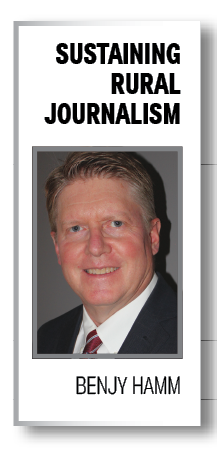Goal-setting can be an important part of improving your newsroom and newspaper
Benjy Hamm
Dec 1, 2024


January is a time when many people set new goals for themselves. There’s something about a new year or a milestone birthday that makes people think more about planning, goals and self-improvement.
Even if you’re not one to make personal New Year’s resolutions, you still should think about what goals you would like for your department or newspaper to accomplish in the coming year.
People who operate day to day — or week to week, as the case may be with weekly newspapers — often don’t take enough time to think about the larger, more important goals for themselves and their news organization.
In many years of working with newspapers and online news sites, I watched as the advertising, circulation and business departments set specific goals for each year and measured their performance against those goals. Newsrooms at larger news organizations sometimes did the same thing, but I found that journalists at smaller newspapers often were reluctant to set goals for various reasons.
The No. 1 reason they cited? News is unpredictable, and priorities are determined by the news. Other times, journalists said they were uncomfortable with trying to measure goals for news coverage and other content, with fears of clunky story quotas or forced adherence to pre-determined plans.
Those concerns are understandable, but they should not lead to the alternative — no goal-setting or planning.
One of the primary differences between a good news organization and a great news organization is planning. Another key difference is the ability to set important goals and reach them.
When I worked at Landmark’s community newspaper division, we realized that many of the annual strategic plans from our newspapers left out the newsroom. So, we asked each newsroom to establish department goals that would lead to improvements for readers, the newspaper and the community.
The newsroom’s goals need to be tied to the overall goals of the newspaper. That seems obvious, but sometimes the newsroom’s goals conflicted with the goals of other departments. For example, one newsroom developed a plan to increase coverage of an adjoining community at the same time the advertising and circulation departments were reducing their efforts in that community because of poor sales.
That exposed a problem with internal communication, among other issues, but at least the fact that the newsroom wrote down its goals led to a fuller discussion about newspaper-wide strategies. And if you think that lack of communication only happens at larger newspapers, then you might be surprised to learn that it occurred at a smaller weekly newspaper.
Goals also need to be specific and, as much as possible, measurable. Everyone needs to understand how you will achieve your goals. A lot of businesses set goals based on the SMART concept — Specific, Measurable, Achievable, Realistic and Time-specific. Using the SMART approach forces you to focus on the most effective ways to achieve your goals, such as clearly identifying the goal (specific), determining how you will know if you reach the goal (measurable) and establishing deadlines (time-specific).
We found that people who are new to goal setting tend to use vague words such as “more” instead of specific measures. For example, if your goal is to increase coverage of high-school sports in your region because that’s important for your audience and helps to differentiate you from a competitor, then you might be tempted to write a goal to do more coverage beyond football and basketball. But what does “more” mean? How many stories are you doing now on those other sports? What types of additional stories would benefit your audience? How specifically do you plan to increase coverage?
One way to judge a goal is to ask how you will know if you reach or exceed it.
Goal setting should begin with discussions about what your audience and potential audience need/want from you as a news organization. What are you already doing well? How can you improve?
Maybe you think the newspaper is not doing enough editorials on local issues. Set a goal that will focus your efforts to improve for 2025.
Let’s say you want to set a goal to have “more” names of community members in the newspaper next year, which is an annual goal for some community newspapers. To determine what more means, you’ll need to know how many were published in the past year. If you don’t have enough time to go back through the past 10-plus months of newspapers to determine your baseline, you can review recent newspapers and establish a goal above those numbers. Another possibility is to establish a minimum goal for each issue and increase that number over time.
The point, of course, is not simply to establish numerical goals, but to tie those goals into improving readership, engagement and circulation while establishing the newspaper/website as the leading source for news and information in your community.
Our time is limited, so it’s essential to focus on the most important goals. In my experience, managers and journalists who don’t take time up front to establish goals often waste more time through the year unnecessarily as they get sidetracked by the all-too-many everyday distractions.
Benjy Hamm is director of the Institute for Rural Journalism, which is based at the University of Kentucky. He previously served as editorial director for Landmark Community Newspapers, as an editor for The New York Times Regional Newspaper Group, and as a reporter and editor for The Associated Press.










